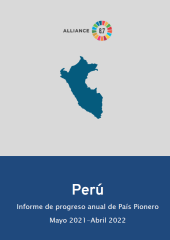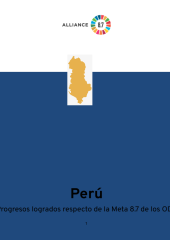Learn more about Peru
Priorities
- Promote the signature of an inter-institutional collaboration agreement with the National Association of Municipalities of Peru (AMPE) and the National Assembly of Regional Governments to implement the Municipal Intervention Model against child labour at the national level 2020-2021.
- Strengthen the social dialogue and institutionality of the Regional Directing Committees for the Prevention and Eradication of Child Labor (CDRPETI) during 2020.
- Implement and link the Child Labor Risk Identification Model – MIRTI to the MIDISTRITO platform of the Ministry of Development and Social Inclusion, for better decision-making in public policy in relation to the prevention and eradication of child labor at the level of local governments (2020).
- Promote supply chains free of child labor in sectors with high incidence and/or at greater risk of child labor (2019-2021).
- Carry out a pilot survey on the prevalence of forced labor in the Cusco region (2019 – 2020) and to roll out the survey nationally to ensure statistical information is available by 2025.
- Promote the process of submission of the 2014 Protocol on the ILO Forced Labor Convention.
- Implement the Third National Plan for the Fight against Forced Labor 2019–2022.
- Develop a project for the reintegration of victims of forced labor and/or human trafficking for the purposes of labor and sexual exploitation, during 2020-2021.
Progress
Successes in the area of Child Labour:
- Approval of the technical document "Guidelines for the implementation of the Municipal Model for the Detection and Eradication of Child Labour", as a strategy that allows preventing, identifying and comprehensively addressing cases of child labour, through concerted action between local governments, regional governments and the central government.
- Implementation of the course "Child Labour and Social Dialogue", to strengthen territorial management for the prevention and eradication of child labour, from the action of the D/GRTPEs and the CDRPETIs.
- Implementation of the Monitora 8.7 platform for the follow-up of work plans of the CDRPETIs of Lambayeque, Piura, Apurímac, Cusco, Lima Provinces and San Martín, from the action of the D/GRTPEs and the CDRPETIs.
- The results of the Child Labour Risk Identification Model in the "Midistrito" Platform, a tool developed to have priority information for each of the country's districts, were linked with a comprehensive, multisectoral and intergovernmental
approach to public interventions, under the auspices of the Ministry of Development and Social Inclusion.
Successes in the area of Forced Labour:
- Promulgation of Ministerial Resolution No. 163-2023-TR, which provides for the prepublication of the draft supreme decree approving the update of the Intersectoral Protocol against Forced labour, published in the Official Gazette El Peruano on April 14, 2023.
Success in the area of Child Labour
- Capacity building for the Regional Steering Committee for the Prevention and Eradication of Child Labour (Comité Directivo Regional para la Prevencion y la Erradicación del Trabajo Infantil – CDRPETI) by updating CDRPETI’s situational diagnosis and providing technical assistance on the development and monitoring of work plans for the prevention and eradication of child labour.
- The Municipal Model for the Detection and Eradication of Child Labour was designed, based on the experiences obtained by four (4) municipalities of the country, which have implemented, as pilot tests, a municipal management model that identifies and refers cases of child labour to competent entities for their comprehensive care.
- Classification of the national territory according to the probability of occurrence of child labour, through the application of the Child Labour Risk Identification Model, which implies the initiation of prioritized, concrete actions in the districts with the highest probability of occurrence of child labour.
Success in the area of Forced Labor
- Ratification of the “Protocol of 2014 to the Forced Labor Convention, 1930”, through Supreme Decree No. 015-2021-RE, published in the Official Gazette El Peruano on April 21, 2021.
Success of Peru as a Pathfinder Country
- Launch of the Recognition “Seal Free of Child Labor” –SELTI, distinctive granted to legal persons (companies, associations, cooperatives) for the promotion of supply chains free of child labour in sectors with high incidence and / or risk of child labour
- Inter-institutional Cooperation Agreement between the Ministry of Labour and Employment Promotion and National Institute of Statistics and Information Technology, which aims at carrying out the collection and processing of information on the prevalence of forced labour in the Cusco region
- Ratification of Protocol of 2014 to the Forced Labour Convention, 1930
- Approval of the Annual Operational Plan for the implementation of the III National Plan to Combat Forced Labour 2019 – 2022.
Strengthening the legal framework
- While Peru as pathfinder country has committed to a number of priorities to tackle child labour and forced labour, additional efforts have been directed towards strengthening the legal framework and national policies against human trafficking. For example:
- Decentralization of public policies on trafficking
- Implementation of the National Plan against Human Trafficking 2017-2021
- Implementation of 23 regional plans against human trafficking in line with the National Plan on Human Trafficking
- International agreements with Chile, Ecuador, Colombia and Argentina
- Approval of the Project of Labour Reintegration of Victims of Forced Labor and/or Human Trafficking for Labour and Sexual Exploitation by the Board of Directors of FONDOEMPLEO
Success in the area of Child Labour
- Capacity building for the Regional Steering Committee for the Prevention and Eradication of Child Labour (Comité Directivo Regional para la Prevencion y la Erradicación del Trabajo Infantil – CDRPETI) by updating CDRPETI’s situational diagnosis and providing technical assistance on the development and monitoring of work plans for the prevention and eradication of child labour.
- The Municipal Model for the Detection and Eradication of Child Labour was designed, based on the experiences obtained by four (4) municipalities of the country, which have implemented, as pilot tests, a municipal management model that identifies and refers cases of child labour to competent entities for their comprehensive care.
- Classification of the national territory according to the probability of occurrence of child labour, through the application of the Child Labour Risk Identification Model, which implies the initiation of prioritized, concrete actions in the districts with the highest probability of occurrence of child labour.
Success in the area of Forced Labor
- Ratification of the “Protocol of 2014 to the Forced Labor Convention, 1930”, through Supreme Decree No. 015-2021-RE, published in the Official Gazette El Peruano on April 21, 2021.
International Instruments
| Area | Ilo Instrument | Status | Ratification date | CEACR comments |
|---|---|---|---|---|
| Child Labour | C138 Ratification of C138 - Minimum Age Convention (1973) |
In Force | 13 Nov 2002 | |
| Child Labour, Forced Labour, Human Trafficking, Modern Slavery | C182 Worst Forms of Child Labour Convention (1999) |
In Force | 10 Jan 2002 | |
| Child Labour, Modern Slavery | C029 Forced Labour Convention (1930) |
In Force | 01 Feb 1960 | |
| Forced Labour, Human Trafficking, Modern Slavery | P029 Protocol of 2014 to the Forced Labour Convention (1930) |
In Force | 18 Jun 2021 | |
| Forced Labour, Modern Slavery | C105 Abolition of Forced Labour Convention (1957) |
In Force | 06 Dec 1960 | |
| Child Labour, Forced Labour, Human Trafficking, Modern Slavery | C143 Migrant Workers (Supplementary Provisions) Convention (1975) |
|||
| Child Labour, Forced Labour, Human Trafficking, Modern Slavery | C181 Private Employment Agencies Convention (1997) |
|||
| Freedom of Association | C087 Freedom of Association and Protection of the Right to Organise Convention (1948) |
In Force | 02 Mar 1960 | |
| Freedom of Association | C098 Right to Organise and Collective Bargaining Convention (1949) |
In Force | 13 Mar 1964 | |
| Discrimination | C100 Equal Remuneration Convention (1951) |
In Force | 01 Feb 1960 | |
| Discrimination | C111 Discrimination (Employment and Occupation) Convention (1958) |
In Force | 10 Aug 1970 | |
| Occupational Safety and Health | C155 Occupational Safety and Health Convention (1981) |
|||
| Occupational Safety and Health | C187 Promotional Framework for Occupational Safety and Health Convention (2006) |
| Area | UN Treaty | Signature date | Ratification date | Status |
|---|---|---|---|---|
| Child Labour | IV-11 Convention on the Rights of the Child (1989) |
26 Jan 1990 | 4 Sep 1990 | |
| Child Labour | IV-11-c Optional Protocol to the Convention on the Rights of the Child on the sale of children, child prostitution and child pornography (2000) |
1 Nov 2000 | 8 May 2002 | |
| Forced Labour, Human Trafficking | PALERMO_PROTOCOL Protocol to Prevent, Suppress and Punish Trafficking in Persons, especially Women and Children, supplementing the United Nations Convention against Transnational Organized Crime (2000) |
14 Dec 2000 | 23 Jan 2002 | |
| Human Trafficking, Modern Slavery | XVIII-4 Ratification of the Supplementary Convention on the Abolition and of Slavery, the Slave Trade and Institutions and Practices Similar to Slavery (1956) |
7 Sep 1956 |
Sources: ILO Normlex & UN Treaty Collection
RESOURCES

Perú - Informe de progreso anual de País Pionero, 2021-2022
Document

Perú - Informe de progreso anual de País Pionero, 2022-2023
Document

Perú - Informe de progreso anual de Pais Pionero, Mayo 2023 - Diciembre 2023
Document

Perú - Informe de progreso anual de Pais Pionero, 2024
Document